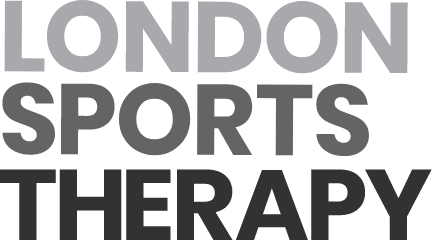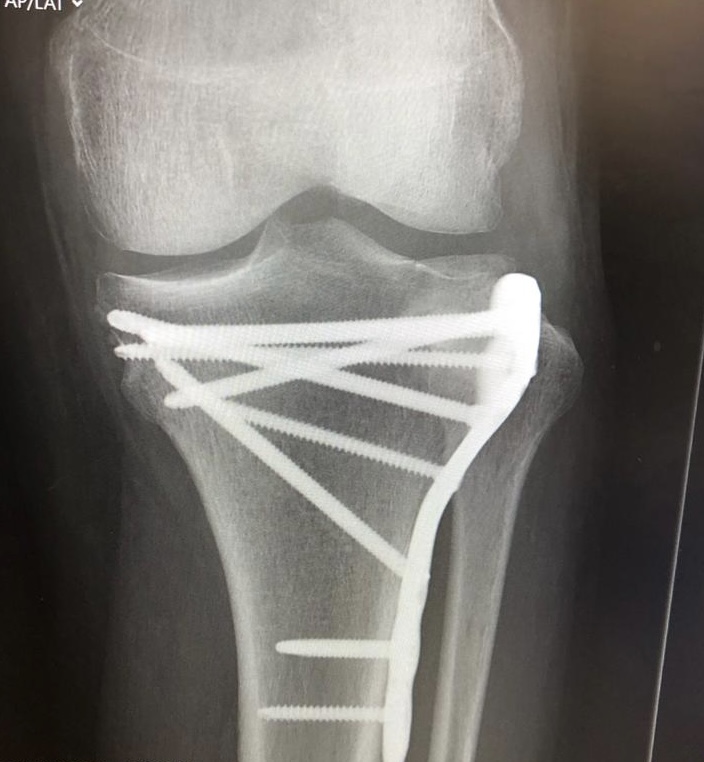Can physical rehabilitation help patients who have undergone surgery or experienced a traumatic injury, such as fractures? What are the benefits of starting rehabilitation early? These are some of the questions we aim to answer in this article. We’ll be sharing the experience of our patient Lisa, who suffered a tibia and fibula fracture that required surgery. So let’s look into some of the benefits of early rehabilitation after surgery.
Tibia and fibula fracture and surgery
Lisa sustained her fracture in France while on a skiing trip. Upon returning to the UK, she got in touch with us to ask for advice. We suggested she had the surgery as soon as possible. Ideally, for optimal results, the bone needs to be fixated in place within a certain window of time to ensure it grows back together in an optimal way and to safely support the person’s weight.
At the time of writing, we have been supporting Lisa during her recovery. The rehab process started post-surgery when Lisa couldn’t put any weight on her leg (we refer to this as non-weight bearing). Lisa is now partially weight-bearing, which means she can put some weight on her leg. However, she still needs support in the form of an orthopedic boot and crutches.
From early rehabilitation, we have therefore been supporting Lisa through to the intermediate rehab stage. Since then, Lisa has been able to join the gym, use the swimming pool, and even start working with a Personal Trainer. We have been taking Lisa through her rehab exercises both in the pool and the gym and regularly liaise with the gym staff so they’re aware of her injury and can keep a close eye on her. As a direct result, she’s been making significant progress in her recovery and recently told us that her surgeon feels she’s further ahead with her healing than expected at this stage.
Watch a short series of pictures and videos from Lisa’s fracture and rehab here.
Benefits of early rehabilitation after surgery or injury
Here are some of the benefits from early rehabilitation that Lisa has been able to reap by working with us:
- Reassurance, help, and motivation. This is both with her physical healing and mental recovery and with her mental health and wellbeing.
- Maintaining confidence, strength, and fitness within the constraints of her injury. This is to avoid losing muscle and to return to previous levels of physical activity as soon as possible.
- Maintaining existing neuromuscular stimulation patterns and mappings.
Let’s look at each of them in more detail.
Smoother and quicker physical and emotional recovery
Any type of traumatic injury or invasive surgery creates stress, both emotionally and physically. And it’s in the best interests of the patient to return to full mobility and health as soon as possible, which is something that early rehabilitation can facilitate.
When she first contacted us (after her fracture but before her surgery) Lisa felt scared and worried. She didn’t know what the road to recovery after surgery might look like. When we first saw Lisa at the clinic after her surgery, we were able to not only reassure her but also arm her with information and confidence. We empowered her to do her exercises, take steps to minimise the pain and swelling of her ankle, knee, and lower leg, and take charge of her own recovery. As a result, Lisa now feels confident and competent in doing her exercises.
At the clinic, we offer a holistic service, which means we are also able to signpost information about training, nutrition, lifestyle, and alternative practices. Hiring a PT following our advice, for example, allowed Lisa to feel even more supported in her recovery. And because of how diligent she is with her exercises, she can see progress.
To her credit, Lisa invested in this process from the very start. And the regular results fuel her commitment further. It’s thanks to her dedication to her rehab journey that we know that Lisa’s recovery will be smoother and faster. And we have no doubt she will be back to full function and to her previous levels of ability and activity as soon as the healing of her fracture allows her to.
Maintaining strength and existing neuromuscular stimulation patterns
Working with us means that Lisa is also less likely to experience any complications in the future. Or to pick up ‘bad habits’ in the way she moves that would take longer to correct later.
With Lisa’s type of fracture, her ankles, hips, and back are also affected. Being non-weight bearing or partially weight-bearing can lead to loss of muscle tissue, joint restrictions (unless they’re addressed with targeted mobility exercises), and weaknesses. When the body experiences weaknesses and restrictions, it finds alternative ways to move. And while those adaptations in movement may be efficient and ‘get the job done’, they aren’t optimal. In fact, overcompensation creates further imbalances in the body. And if not spotted, addressed, and corrected, this can generate a knock-on effect on other parts of the body and even become chronic.
If you want to find out more about how injuries can impact the way we move, head over to the blog post, How Old Injuries can Affect the Way You Move.
Re-training the body
Our instinct as humans is always to protect the part of the body that was injured or where we had surgery. In other words, we avoid using that limb, joint, or affected muscles. And when the body gets used to these alternative ways of moving, it forms new neuromuscular stimulation patterns or maps. Why? Because the existing ones are interrupted or no longer viable. For example, because the person cannot put any weight on their leg.
As an example, take a look at this video from a patient who had ACL surgery – look at the way she moves differently on the two sides of her body.
And relearning the previous patterns can take time and conscious work – re-mapping your brain takes time and effort! And if newly-formed patterns aren’t corrected, they simply stay. It’s why someone may have a limp, for example. Or walk or climb stairs in such a way that doesn’t engage the right muscles.
So by working alongside the patient during their rehabilitation, we’re able to advise them so they don’t lose strength in other parts of the body. We also help them maintain optimal mobility, range of movement, and function within the constraints of their injury. And at the same time, we support the patient so they can avoid falling into overcompensation patterns, developing weaknesses or complications, or experiencing chronic pain.
Prehab and early rehabilitation after surgery
Lisa’s case study shows how rehabilitation has been particularly useful following her fracture and surgery. But both prehab and early rehab can bring positive benefits for other types of elective or invasive surgeries, including:
- ACL surgery.
- Bunion surgery.
- Spinal surgery.
- Knee or hip replacement surgery.
Because any type of traumatic or invasive event has an impact on the body, we always recommend you consider early rehabilitation. We like to see this not as an optional bonus but as a key, necessary component of the recovery and healing journey.
Bunion surgery, for example, is often (bar some exceptions) an elective or cosmetic type of surgery. And while it can affect someone who’s genetically prone, a bunion is the result of overcompensation. After surgery, we advise you to address the overcompensation. If not, the foot could become rigid and create further imbalances, complications, and pain.
Get our help with an injury or surgery
If you have experienced an injury or are planning or have just had elective or restorative surgery, we can help with your prehab or rehabilitation. You can call us on 07976 202 766 or email us at info@londonsportstherapy.com. Or, if you’d like an in-person consultation, you can book online here.

